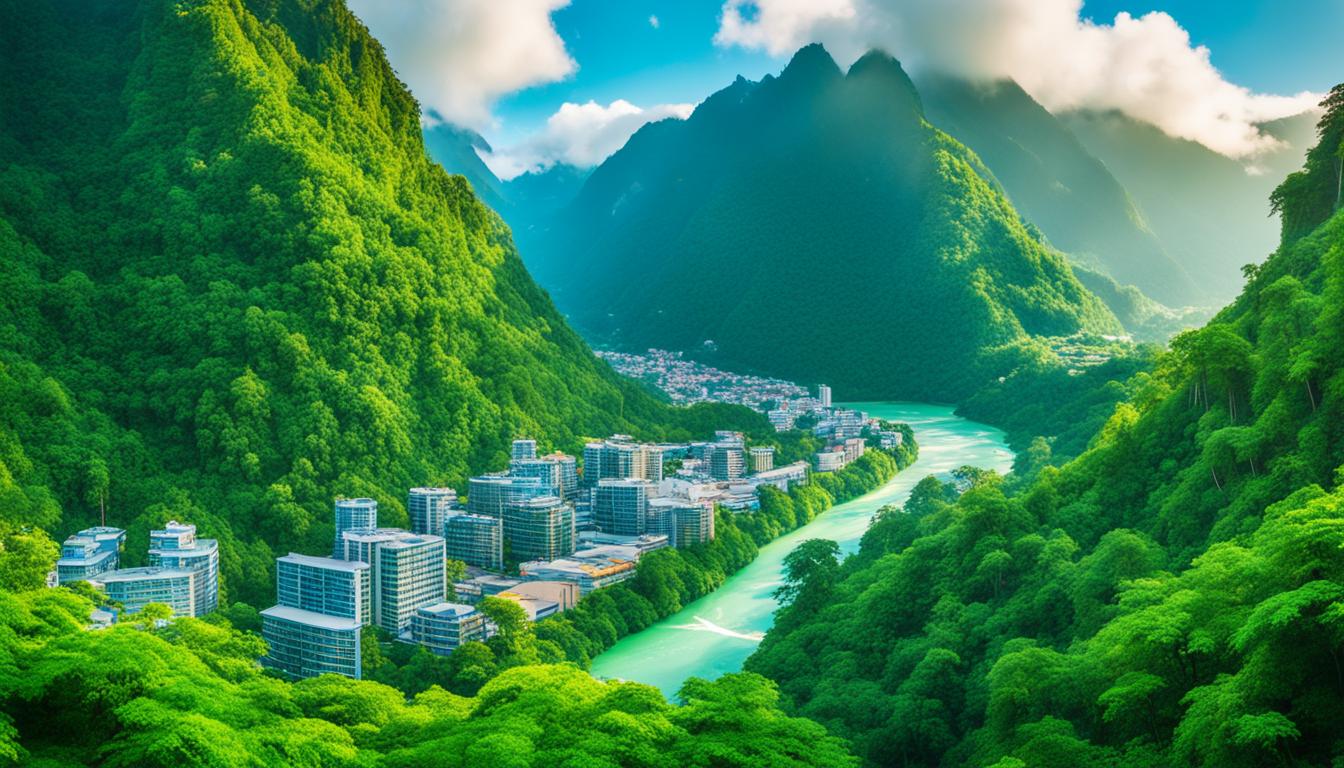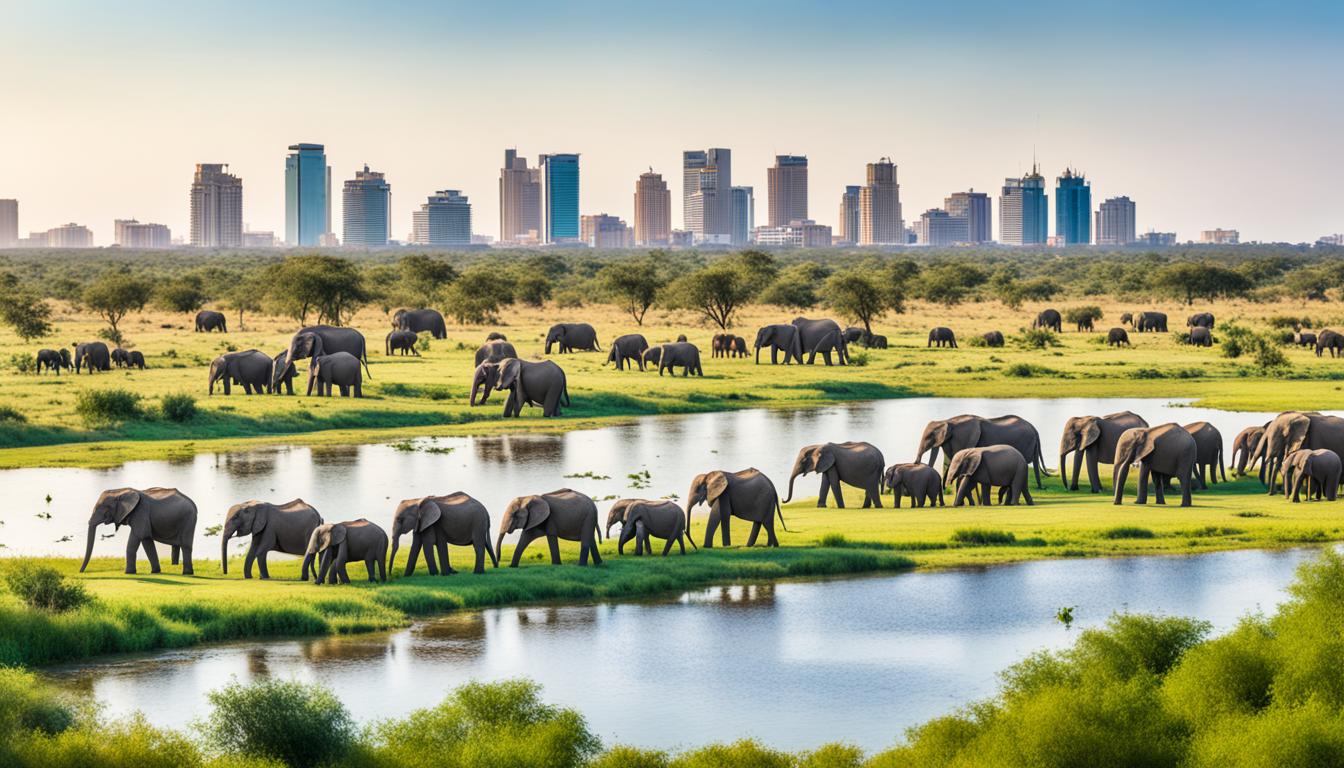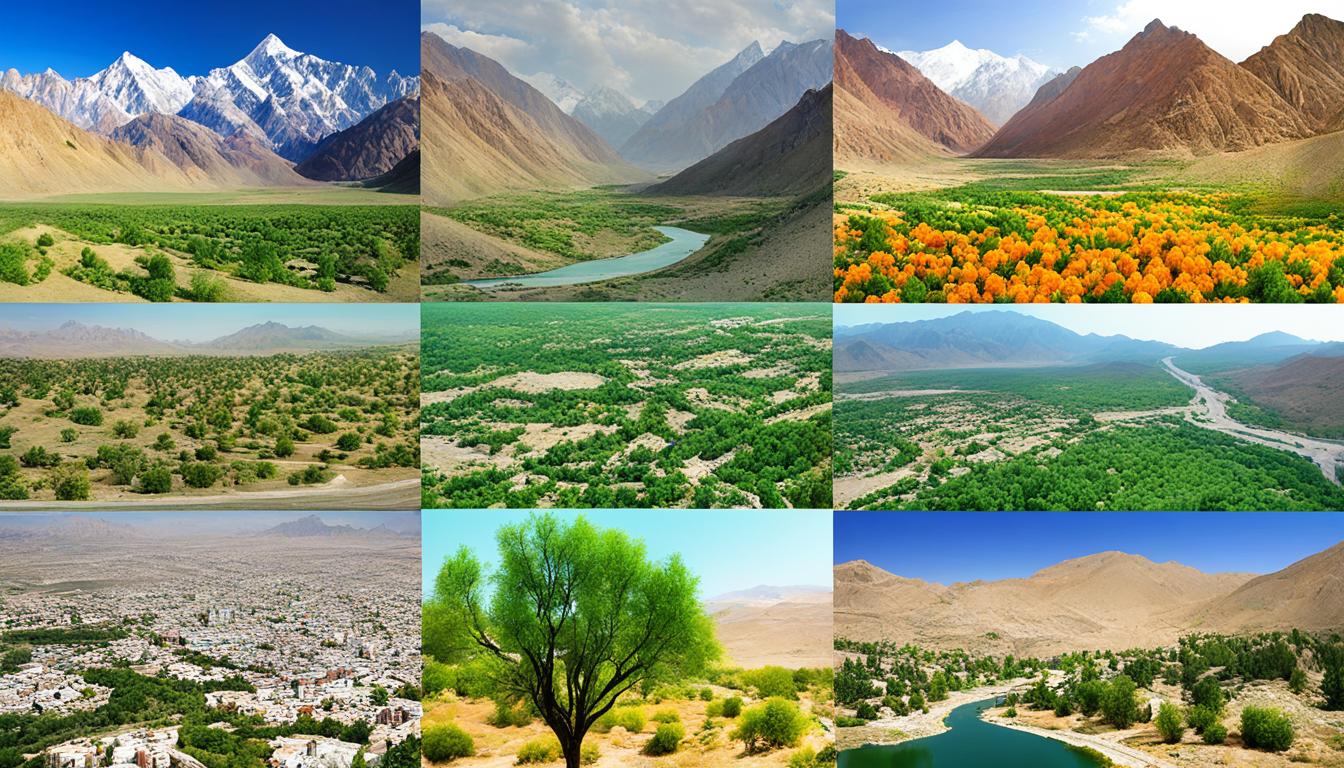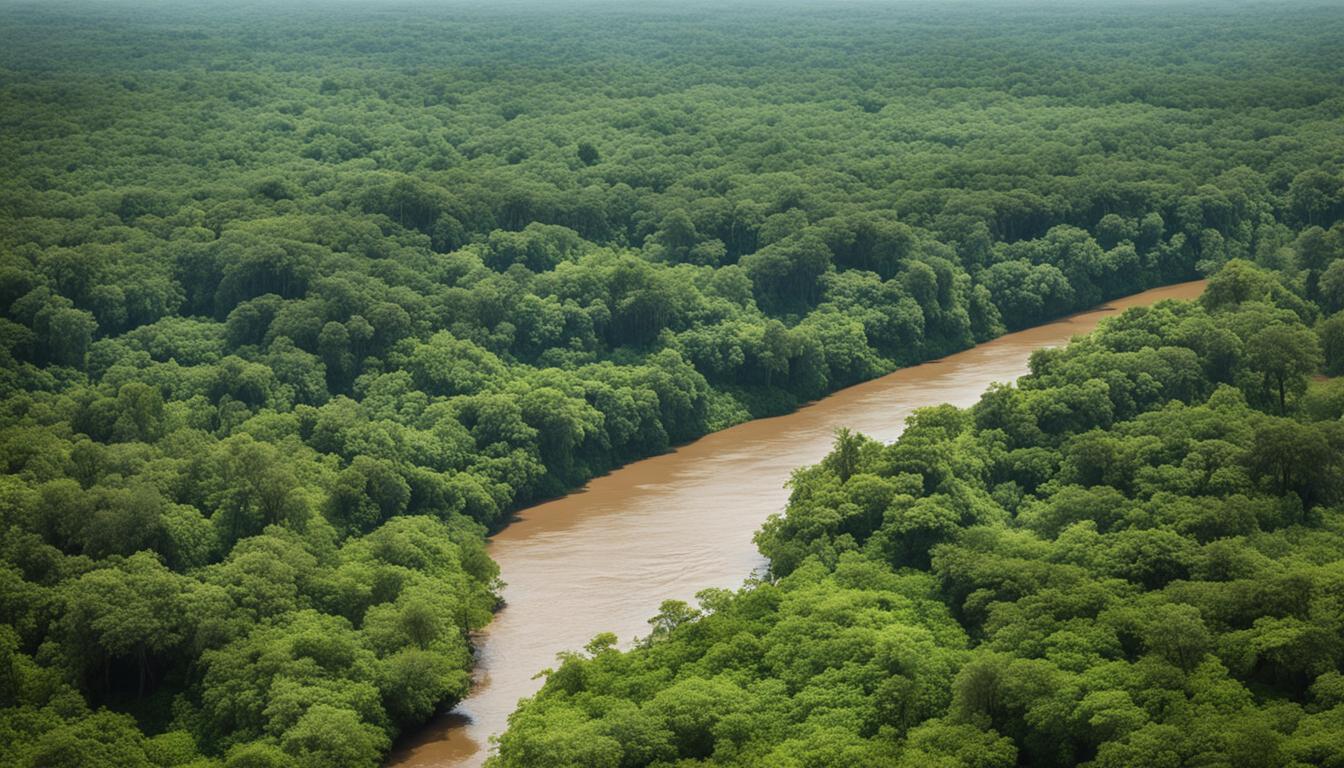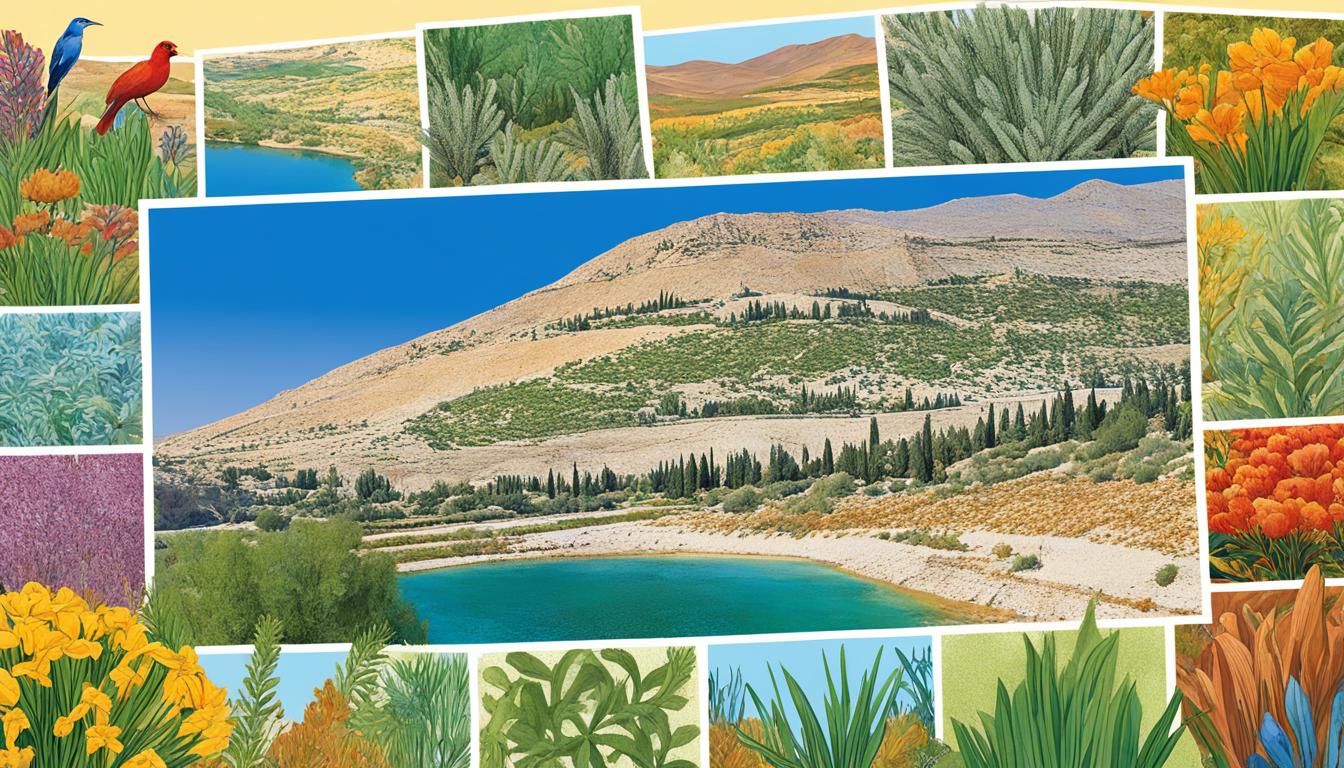Bosnia and Herzegovina Biodiversity and the Built Environment
Welcome to our exploration of Bosnia and Herzegovina’s fascinating biodiversity and its intricate relationship with the built environment. Situated in the heart of the Balkans, this beautiful country is renowned for its diverse animal and plant species, making it a hotspot for biodiversity in the region. From lush forests to stunning landscapes, Bosnia and Herzegovina is a treasure trove of unique endemic species and habitats that contribute to its ecological significance.
With approximately 5,000 confirmed plant species, including endemic flora, Bosnia boasts a rich tapestry of botanical wonders. Vibrant wildflowers, ancient trees, and rare medicinal plants are just a glimpse of the country’s remarkable flora. The animal kingdom in Bosnia is equally captivating, home to diverse wildlife including mammals, birds, reptiles, and amphibians. It’s a haven for rare and endangered species, making it a crucial area for biodiversity research and conservation efforts.
Key Takeaways:
- Bosnia and Herzegovina is a hotspot for biodiversity in the Balkans.
- The country is home to approximately 5,000 plant species, including endemic flora.
- The animal kingdom in Bosnia is rich and diverse compared to other countries in the region.
- Bosnia’s biodiversity faces threats from climate change, land-use change, and urbanization.
- Conservation efforts and research play a vital role in preserving Bosnia’s natural heritage.
Exploring Bosnia’s Biodiversity
From endemic species to unique habitats, Bosnia’s biodiversity is a treasure worth exploring and protecting. In terms of flora, Bosnia and Herzegovina is home to approximately 5,000 confirmed plant species, with 30% of the total endemic flora in the Balkans found in the country. The stunning array of plant life includes vibrant wildflowers, ancient trees, and rare medicinal plants. The animal kingdom in Bosnia is equally captivating, with diverse wildlife including mammals, birds, reptiles, and amphibians. The country provides a rich habitat for many rare and endangered species and is an important area for bird migration.
To truly appreciate the biodiversity of Bosnia, one must delve into its unique habitats. The country boasts a variety of ecosystems, ranging from lush forests and dense wetlands to high-mountainous regions and limestone caves. Each habitat supports a distinct assemblage of plant and animal species, contributing to the overall richness of Bosnia’s biodiversity.
Biodiversity research plays a vital role in understanding and conserving Bosnia’s natural heritage. Scientists and researchers are actively engaged in studying the country’s flora and fauna, documenting new species, and investigating the ecological relationships within different habitats. This research provides valuable insights into the distribution, abundance, and conservation needs of Bosnia’s endemic and endangered species.
“Bosnia’s rich biodiversity is a testament to the country’s ecological importance and the need for comprehensive conservation efforts,” says Dr. Anisa Petrovic, a leading biodiversity researcher. “By studying and understanding the intricate web of life in Bosnia, we can better protect and preserve the unique ecosystems and species that call this country home.”
Bosnia’s commitment to conservation efforts is evident through the establishment of protected areas and the implementation of sustainable practices. National parks, nature reserves, and wildlife corridors serve as havens for endangered species, allowing them to thrive in their natural habitats.
Examples of Endemic Species in Bosnia
Bosnia’s endemic species showcase the country’s unique biodiversity, with some plants and animals found nowhere else on Earth. Here are a few notable examples:
| Flora | Fauna |
|---|---|
| Bosnian pine (Pinus heldreichii) | Bosnia and Herzegovina common newt (Triturus vulgaris) |
| Bosnian lily (Lilium bosniacum) | Dinaric lynx (Lynx lynx dinniki) |
| Bosnian iris (Iris bosniaca) | Balkan green lizard (Lacerta trilineata) |
Bosnia’s endemic species are not only valuable in terms of biodiversity, but they also contribute to the cultural and historical heritage of the country. Preserving their habitats and ensuring their survival is crucial for maintaining the unique identity of Bosnia and Herzegovina.
Exploring and protecting Bosnia’s biodiversity requires a collaborative effort between scientists, conservationists, policymakers, and local communities. By working together, we can safeguard the country’s natural heritage and ensure a sustainable future for generations to come.
Biodiversity Research and Conservation
Scientists and conservationists in Bosnia are actively engaged in studying and documenting the country’s biodiversity. Through field surveys, genetic studies, and ecological monitoring, they are gaining valuable insights into the distribution, abundance, and ecological roles of various species.
Conservation efforts focus on preserving key habitats, implementing sustainable land-use practices, and raising awareness among local communities. These initiatives aim to safeguard the rich biodiversity of Bosnia for future generations.
Several key biodiversity conservation organizations play a crucial role in driving these efforts:
- The Bosnia Wildlife Society is dedicated to protecting and conserving the country’s wildlife and their habitats. Through research, education, and community engagement, they strive to promote sustainable practices and biodiversity conservation.
- The Nature Conservation Movement focuses on preserving Bosnia’s natural heritage through advocacy, environmental education, and fieldwork. They work closely with local communities, government agencies, and international partners to promote conservation and sustainable development.
- The Bosnia and Herzegovina Environmental Protection Fund plays a vital role in funding and supporting biodiversity conservation projects. By providing grants and resources, they enable researchers and conservationists to carry out essential work in preserving Bosnia’s unique ecosystems.
These organizations are at the forefront of biodiversity research and conservation, working tirelessly to protect Bosnia’s natural treasures and raise awareness about the importance of preserving the country’s rich biodiversity.
Biodiversity Research and Conservation Organizations
| Organization Name | Description |
|---|---|
| Bosnia Wildlife Society | Aims to protect and conserve wildlife and their habitats through research, education, and community engagement. |
| Nature Conservation Movement | Focuses on preserving natural heritage through advocacy, environmental education, and fieldwork. |
| Bosnia and Herzegovina Environmental Protection Fund | Provides funding and resources to support biodiversity conservation projects in Bosnia and Herzegovina. |
Conservation Efforts and their Impact
“Our research and conservation efforts are crucial in protecting Bosnia’s rich biodiversity and ensuring its long-term survival. By studying and documenting the distribution and abundance of species, we can better understand their ecological roles and implement effective conservation strategies. Through collaborations with local communities and organizations, we can raise awareness about the importance of preserving our natural heritage. Together, we can make a significant impact in safeguarding the unique ecosystems of Bosnia.” – Dr. Marko Petrovic, Conservation Scientist
Flora of Bosnia: A Rich Tapestry of Plant Life
The vibrant flora of Bosnia boasts thousands of plant species, including 30% of the total endemic flora in the Balkans. The country’s diverse landscapes, geological and climatic regions create a favorable environment for the growth of different species. Notable plant species found in Bosnia include the Bosnian pine (Pinus heldreichii) and the Bosnian lily (Lilium bosniacum). These plant species not only add beauty to the landscape but also play a crucial role in supporting local ecosystems, providing habitats for various animal species, and serving as a source of food and medicine.

Wildlife in Bosnia: An Abundance of Fauna
Bosnia’s wildlife is brimming with a diverse array of species, ranging from mammals to birds, reptiles, and amphibians. Thanks to the country’s unique geographical location and favorable climate, it attracts numerous animals, allowing for a thriving and diverse fauna. Visitors to Bosnia may encounter fascinating wildlife such as the European brown bear, Eurasian lynx, and the Balkan chamois.
Conservation efforts in Bosnia are dedicated to safeguarding these remarkable species and their natural habitats. The establishment of national parks, nature reserves, and wildlife corridors ensures the protection and preservation of Bosnia’s wildlife and their ecosystems. By investing in wildlife conservation, Bosnia and Herzegovina not only preserves its natural heritage but also ensures ecological balance for future generations.
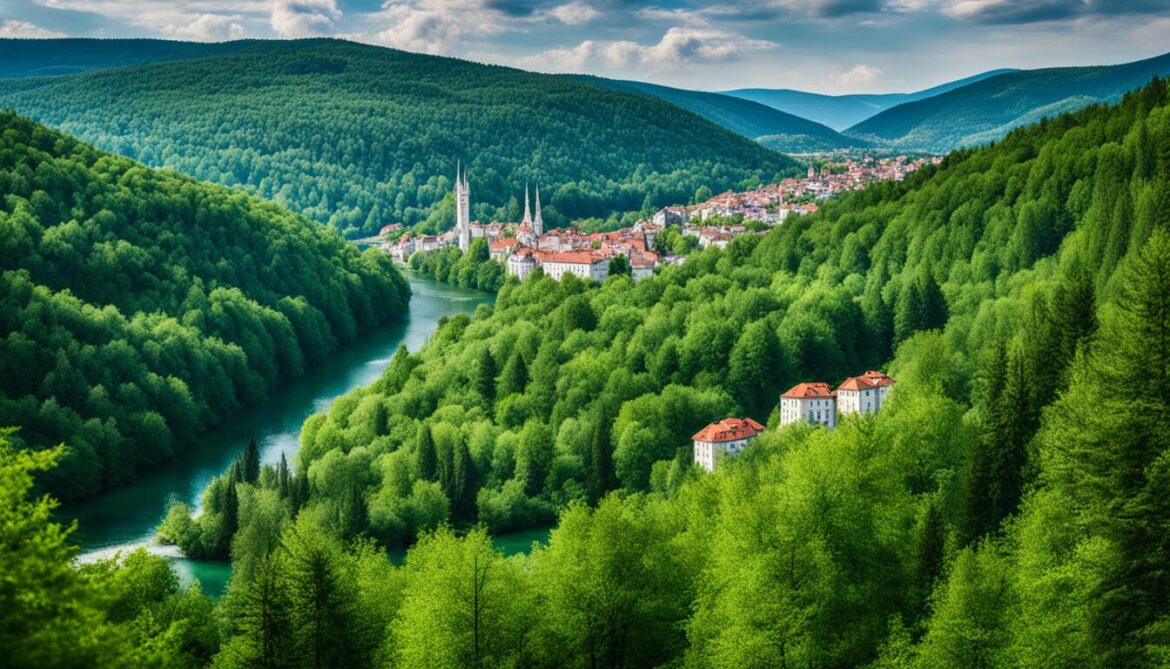
The Impressive Wildlife of Bosnia
The wildlife in Bosnia is rich and diverse, with various species inhabiting different regions of the country. Here are some notable examples:
| Animal Species | Description |
|---|---|
| European Brown Bear (Ursus arctos arctos) | The European brown bear is one of the largest land predators in Europe. It can be found in the mountainous regions of Bosnia, primarily in areas with ample forest cover. |
| Eurasian Lynx (Lynx lynx) | The Eurasian lynx is a medium-sized wildcat known for its distinctive tufted ears and short tail. This elusive predator can be found in secluded and forested areas, where it preys on small mammals. |
| Balkan Chamois (Rupicapra rupicapra balcanica) | The Balkan chamois is a subspecies of chamois that inhabits mountainous regions in the Balkans, including Bosnia. It is known for its agility and ability to navigate steep rocky terrains. |
“The wildlife in Bosnia is a testament to the country’s commitment to biodiversity conservation and the remarkable variety of species that call it home.” – Wildlife Conservation Society
The diverse fauna in Bosnia contributes to the country’s ecological significance and serves as an important indicator of the overall health of its ecosystems. Ongoing conservation efforts help protect these animals and their habitats, ensuring the long-term sustainability of Bosnia’s wildlife and promoting a harmonious coexistence between humans and nature.
Threats to Bosnia’s Biodiversity
Despite its natural beauty, Bosnia’s biodiversity is under threat from various factors, including climate change, land-use change, and urbanization. These threats pose significant challenges to the preservation of Bosnia’s unique ecosystems and the diverse species that call it home.
The Impact of Climate Change
Climate change has emerged as a major threat to Bosnia’s biodiversity, particularly in regions such as the Alpine-Nordic and Mediterranean areas. Rising temperatures, changing precipitation patterns, and increased frequency of extreme weather events have the potential to disrupt ecosystems and disturb the delicate balance of nature. This, in turn, can lead to habitat loss, species displacement, and even extinction.
Land-Use Change and Habitat Loss
Land-use change, driven by factors such as agricultural expansion, deforestation, and infrastructure development, is another significant threat to Bosnia’s biodiversity. As urban areas expand and agricultural practices intensify, natural habitats are being fragmented and destroyed. This loss of habitat not only affects the species directly impacted but also disrupts the interconnected web of life, leading to cascading effects throughout the ecosystem.
Urbanization and Impacts on Wildlife
The rapid pace of urbanization in Bosnia presents additional challenges for biodiversity conservation. As cities and towns expand, natural areas are being converted into built environments, resulting in the loss of crucial habitats for many plant and animal species. Urbanization also brings increased pollution, noise, and human disturbance, further threatening the survival of wildlife populations.
“The rapid urbanization in Bosnia puts immense pressure on our natural resources and delicate ecosystems. It is crucial that we find a balance between development and conservation to safeguard our biodiversity for future generations.” – Dr. Marko Petrovic, Environmental Scientist
The Future of Coastal Areas
Bosnia’s coastal areas face a specific threat from projected sea-level rise and the intrusion of saltwater. As global temperatures continue to rise, coastal ecosystems and the species that rely on them for survival are at risk. Salinization of freshwater sources, increased erosion, and the loss of coastal wetlands are some of the potential consequences that could result in significant ecological impacts.
To protect Bosnia’s biodiversity, immediate action is needed to address these threats. This includes implementing sustainable practices, promoting responsible land-use planning, and raising awareness about the importance of biodiversity conservation among communities, policymakers, and businesses.
Key Threats to Bosnia’s Biodiversity
| Threat | Impact |
|---|---|
| Climate Change | Disruption of ecosystems, habitat loss, species displacement, and potential extinction |
| Land-Use Change | Fragmentation and destruction of natural habitats, loss of biodiversity |
| Urbanization | Loss of habitats, increased pollution, noise, and disturbance to wildlife |
| Rising Sea Levels | Salinization of freshwater sources, erosion, and loss of coastal wetlands |

By addressing these threats and working together to prioritize biodiversity conservation, Bosnia can protect its unique natural heritage and ensure a sustainable future for both humans and wildlife.
Endangered Ecosystems in Bosnia
Bosnia’s high-mountainous ecosystems, including the Dinaric Alps, are home to several endangered species and are in need of preservation to safeguard their biodiversity. These ecosystems provide vital habitats for a wide range of plant and animal species, many of which are endemic to the region. However, these ecosystems are vulnerable to threats posed by climate change and human activities. Preservation efforts must focus on protecting these endangered ecosystems to ensure the survival of their unique biodiversity.

Key Endangered Ecosystems in Bosnia
| Ecosystem | Main Threats |
|---|---|
| High-Mountainous Ecosystems | Climate change, habitat degradation |
| Sub-Mediterranean Forests | Forest fragmentation, invasive species |
| Riparian Zones | Hydrological disturbances, pollution |
The high-mountainous ecosystems in Bosnia, such as the Dinaric Alps, are characterized by their unique alpine flora and fauna. These ecosystems are under threat from climate change, as rising temperatures and shifting precipitation patterns can disrupt the delicate balance of these high-altitude habitats. Habitat degradation caused by deforestation, overgrazing, and infrastructure development also poses a significant risk to these ecosystems.
Sub-Mediterranean forests, found primarily in the southwest region of the country, are facing challenges like forest fragmentation and the invasion of non-native species. Fragmentation disrupts the natural connectivity between forest patches, leading to a loss of biodiversity and reduced ecological resilience. Invasive species, introduced through human activities, can outcompete native species and alter ecosystem dynamics.
Riparian zones, which encompass the banks of rivers and streams, are critical for maintaining water quality and supporting diverse aquatic and terrestrial life. However, hydrological disturbances caused by dam construction and water extraction, along with pollution from agricultural runoff and industrial activities, pose threats to these important ecosystems.
“Preservation efforts must focus on protecting these endangered ecosystems to ensure the survival of their unique biodiversity.”
The preservation of Bosnia’s endangered ecosystems requires a holistic approach encompassing habitat preservation, sustainable land-use practices, and active conservation efforts. It is crucial to raise awareness among local communities about the value of these ecosystems and the importance of their preservation for future generations.
By prioritizing the protection of these endangered ecosystems, Bosnia can not only safeguard its unique biodiversity but also contribute to global conservation efforts and ensure a sustainable future for both nature and communities.
Water Resources and Energy in Bosnia
Bosnia and Herzegovina is blessed with abundant water resources, boasting significant rivers such as the Drina, Neretva, Sava, Bosna, and Una. These water sources play a pivotal role in the country’s economic growth, particularly in terms of hydroelectric power generation.
Hydroelectric power is a renewable energy source derived from the force of flowing water. In Bosnia, hydroelectric power plants harness the natural energy of rivers to produce electricity, contributing to the nation’s energy needs in an environmentally friendly manner.
Despite the immense potential for hydro-power, the utilization rate of hydropotential in Bosnia is relatively low. The country has the opportunity to further improve its energy efficiency and capitalize on renewable energy sources, reducing its reliance on fossil fuels.
To achieve these goals, it is crucial to enhance water management practices and invest in improving infrastructure. This includes the development of modern hydroelectric power plants, alongside the implementation of sustainable and eco-friendly practices.
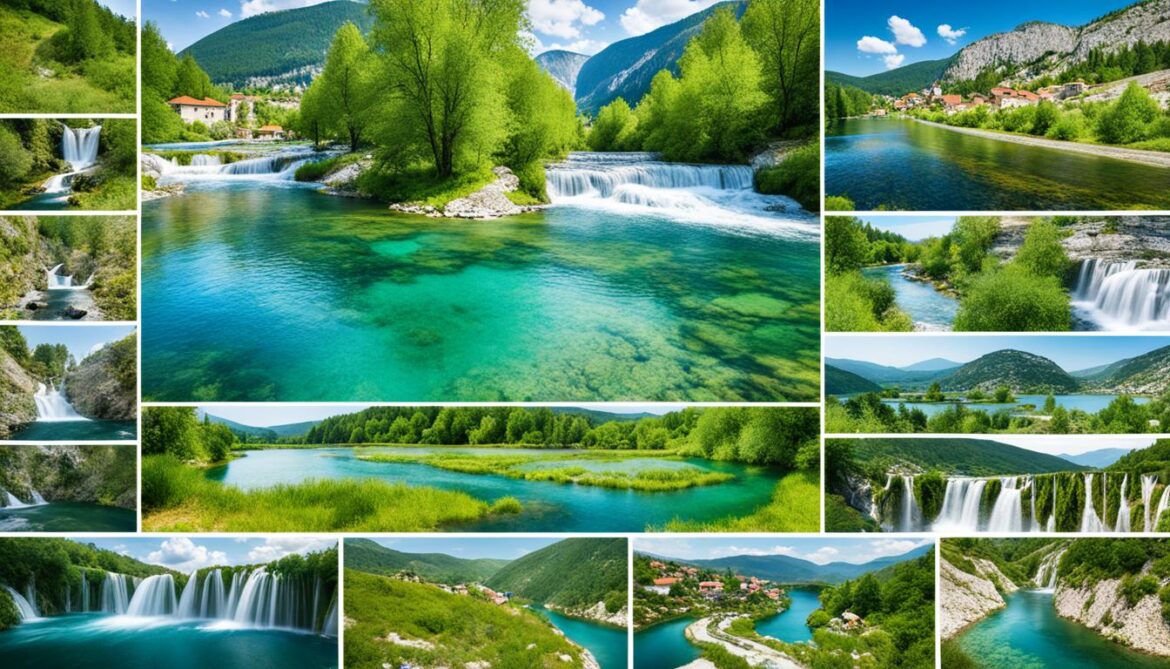
Environmental Conservation and Legislation
Bosnia and Herzegovina has implemented environmental laws to safeguard its natural resources and protect biodiversity. However, there remain gaps and weaknesses in the enforcement and implementation of these laws, posing challenges to environmental conservation efforts. One of the significant concerns is the occurrence of environmental crimes, particularly forestry theft, which can have detrimental effects on the country’s precious ecosystems.
Protected areas, including national parks and Ramsar sites, play a vital role in preserving Bosnia’s biodiversity and natural habitats. These designated areas provide refuge for diverse plant and animal species, acting as sanctuaries for their survival and fostering conservation efforts.
To ensure the long-term sustainability of Bosnia’s biodiversity and built environment, it is imperative to improve the effectiveness of environmental conservation efforts and strengthen legislation and enforcement. This includes enhancing monitoring and enforcement mechanisms, promoting public awareness about the importance of conservation, and nurturing collaboration between relevant stakeholders.
| Key Points | Actions |
|---|---|
| Enhance legislation | Strengthen environmental laws and regulations, filling existing gaps and addressing weaknesses in implementation. |
| Improve enforcement | Boost monitoring and enforcement efforts to combat environmental crimes and protect natural resources. |
| Expand protected areas | Establish additional protected areas to conserve biodiversity and safeguard crucial habitats. |
| Enhance public awareness | Educate and engage local communities about the value of environmental conservation and their role in preserving biodiversity. |
| Support collaboration | Foster partnerships and cooperation among relevant stakeholders, including government agencies, NGOs, and local communities. |
By implementing these measures, Bosnia and Herzegovina can bolster its environmental conservation efforts, protect its natural heritage, and pave the way for a sustainable future.
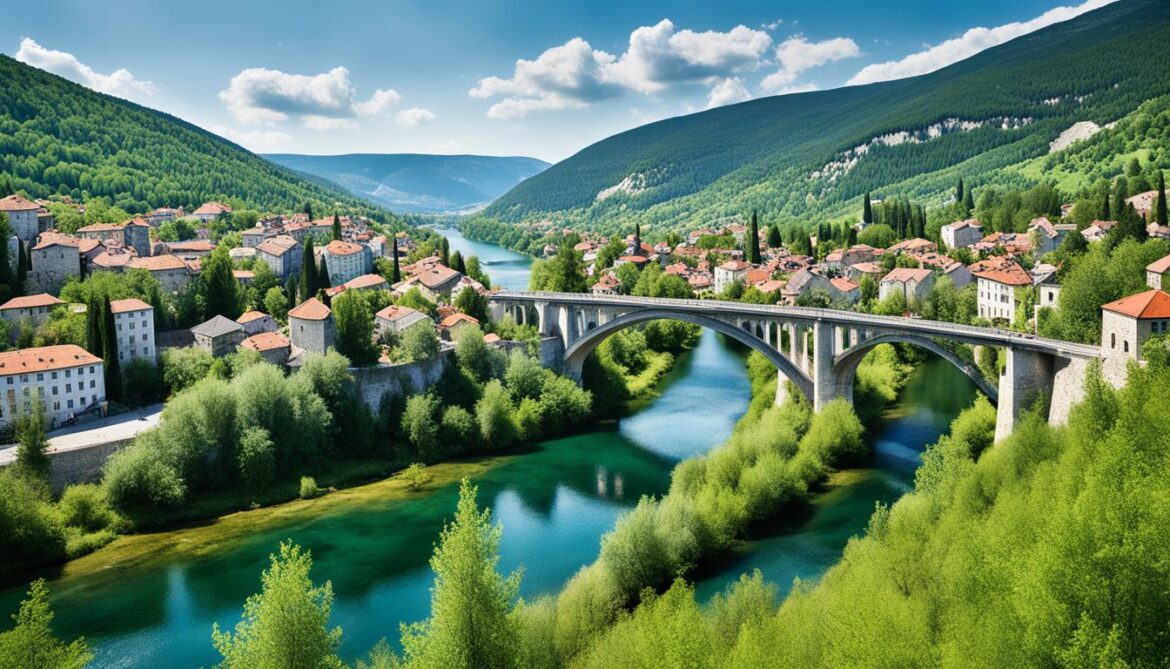
Conclusion
Bosnia and Herzegovina possesses a remarkable biodiversity and built environment that demand safeguarding and sustainable development. With a rich variety of plant and animal species, as well as unique habitats and thriving ecosystems, the country holds significant ecological value. It is crucial to prioritize conservation endeavors, engage in biodiversity research, and raise awareness to protect Bosnia’s natural heritage for the benefit of future generations.
By striking a balance between conserving biodiversity and promoting urban development, while also implementing sustainable practices, Bosnia and Herzegovina can pave the way for prosperous cities and ensure the long-term well-being of its ecosystems. This approach will allow for the coexistence of thriving urban areas and the preservation of the country’s remarkable flora and fauna.
Embracing sustainable development strategies, backed by scientific research and supported by robust conservation efforts, will be instrumental in maintaining the delicate equilibrium between societal progress and ecological integrity. Through collective efforts and a commitment to responsible stewardship, Bosnia and Herzegovina can navigate the path towards a sustainable future, where the country’s biodiversity and built environment thrive harmoniously.
FAQ
What makes Bosnia and Herzegovina biodiverse?
Bosnia and Herzegovina is renowned for its rich tapestry of flora and fauna, with approximately 5,000 confirmed plant species, including endemic flora, and a diverse range of wildlife species.
What are the key conservation efforts in Bosnia?
Conservation efforts in Bosnia include preserving key habitats, implementing sustainable land-use practices, and raising awareness among local communities. Key biodiversity conservation organizations in Bosnia include the Bosnia Wildlife Society, Nature Conservation Movement, and the Bosnia and Herzegovina Environmental Protection Fund.
Can you provide examples of plant species found in Bosnia?
Some notable plant species found in Bosnia include the Bosnian pine (Pinus heldreichii) and the Bosnian lily (Lilium bosniacum).
What kind of wildlife can be found in Bosnia?
Bosnia is home to diverse wildlife, including mammals, birds, reptiles, and amphibians. It provides habitats for species such as the European brown bear, Eurasian lynx, and Balkan chamois.
What are the threats to Bosnia’s biodiversity?
Climate change, land-use change, and urbanization pose significant threats to Bosnia’s biodiversity.
Which ecosystems in Bosnia are endangered?
High-mountainous ecosystems, including the Dinaric Alps, are endangered in Bosnia and require preservation efforts.
What is the importance of water resources in Bosnia?
Water resources play a crucial role in Bosnia’s economic expansion, particularly in terms of hydroelectric power generation.
Are there any environmental laws in Bosnia?
Bosnia and Herzegovina has environmental legislation in place to protect its natural resources and biodiversity.
How can Bosnia balance biodiversity conservation and urban development?
By implementing sustainable practices and raising awareness, Bosnia can create thriving cities while ensuring the long-term well-being of its ecosystems.



